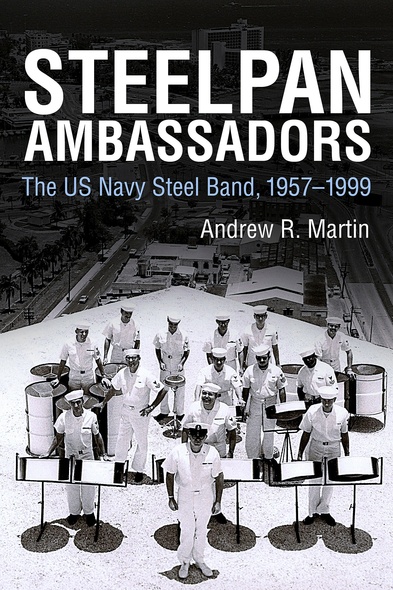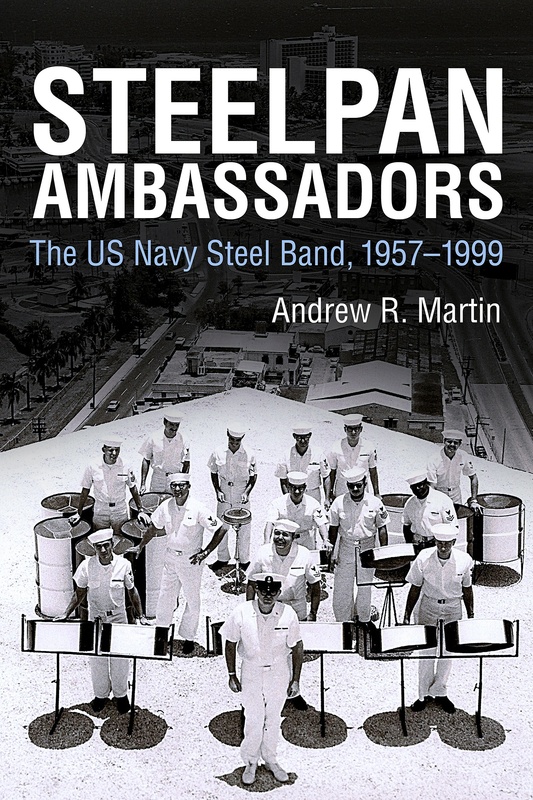Our shopping cart is currently down. To place an order, please contact our distributor, UTP Distribution, directly at utpbooks@utpress.utoronto.ca.

Steelpan Ambassadors
The US Navy Steel Band, 1957–1999
“Maybe you won’t like steel band. It’s possible. But it’s been said that the Pied Piper had a steel band helping him on his famous visit to Hamelin.” When the US Navy distributed this press release, anxieties and tensions of the impending Cold War felt palpable. As President Eisenhower cast his gaze towards Russia, the American people cast their ears to the Atlantic South, infatuated with the international currents of Caribbean music. Today, steelbands have become a global phenomenon; yet, in 1957 the exotic sound and the unique image of the US Navy Steel Band was one-of-a-kind. Could calypso doom rock “n' roll? Band founder Admiral Daniel V. Gallery thought so and envisioned his steelband knocking “rock “n' roll and Elvis Presley into the ash can.”
From 1957 until their disbandment in 1999, the US Navy Steel Band performed over 20,000 concerts worldwide. In 1973, the band officially moved headquarters from Puerto Rico to New Orleans and found the city and annual Mardi Gras tradition an apt musical and cultural fit. The band brought a significant piece of Caribbean artistic capital—calypso and steelband music—to the American mainstream. Its impact on the growth and development of steelpan music in America is enormous.
Steelpan Ambassadors uncovers the lost history of the US Navy Steel Band and provides an in-depth study of its role in the development of the US military’s public relations, its promotion of goodwill, its recruitment efforts after the Korean and Vietnam Wars, its musical and technological innovations, and its percussive propulsion of the American fascination with Latin and Caribbean music over the past century.
In this lively and insightful book, Andrew Martin presents the surprising story of the US Navy Steel Band, from its inception in 1957 in Puerto Rico to its national and international tours, LP recordings, television and film appearances, relocation to New Orleans in 1973, and impact on many school steelbands. Drawing on interviews, archival documents, newspaper articles, audio and visual media, and other sources, Martin develops a cogent analysis of this unusual ensemble in the context of American diplomacy, military public relations, fantasies of the Caribbean, and cultural appropriation and innovation during the post-World War II era and after. Through careful attention to both musicianship and social networks, he demonstrates the important but largely forgotten role that the ensemble played in disseminating steelband music to new audiences across the Americas and beyond.
Steelpan Ambassadors contains a thorough and factual history of the story of the US Navy Steel Band—arguably the most important non-Trinidadian steelband the world has ever known. It describes the emotions, trials, and tribulations of its band members as they emerged wholeheartedly into absorbing the instruments first made by Trinidadian Ellie Mannette as a means of musical expression. This book takes a deep dive into the musical repertoire and active performance schedules of the US Navy Steel Band and contains countless stories about the love, dedication, and respect these Americans had for the steelpan. As cultural ambassadors, the US Navy Steel Band became a household name as they touched the hearts of listeners all over the world. Their musical adaptations were done in an authentic Trinidadian style that had audiences of any age tapping their feet and smiling. In addition to their work in America, this book adeptly captures the influence the US Navy Steel Band had back in Trinidad where stories of the success of the band helped justify the acceptance of the steelpan as a viable instrument of labor and love that embraced the world. This book is a must-read for lovers of steelbands and for anyone interested in steelpan history.
Andrew R. Martin is professor of music at Inver Hills College. His research explores the global spread of steelpan and steelbands, American music, and popular and folk music and musicians since the Cold War. Since 2011, Martin has written a semi-regular newspaper column, "Pan Worldwide," for the Trinidad Guardian.




